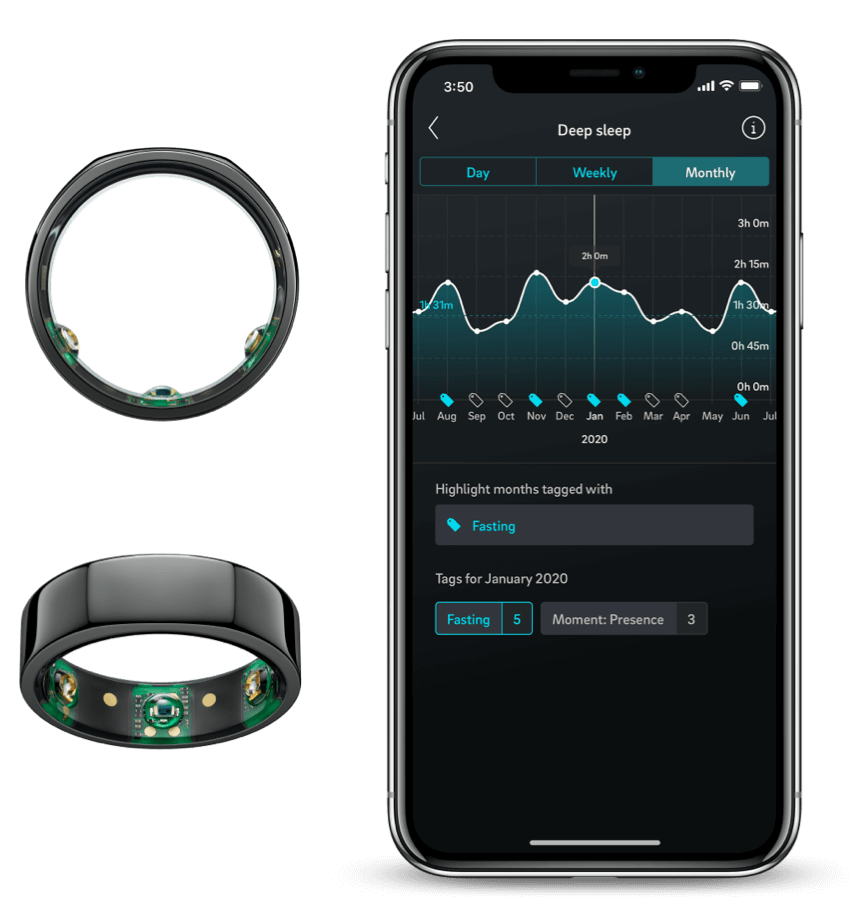Why Our Favorite Health Tracker Isn’t a Watch
Maybe you’ve heard that the NBA is using it to help predict cases of COVID-19 before players show symptoms. You might have read Silicon Valley trendsetters—like Twitter CEO Jack Dorsey—praising the way it’s helped them better understand their states of mind. We’re talking about the Oura Ring, the sleek, sensor-filled wearable that TechCrunch called the “personal health tracking device to beat in 2020.”
Back when Oura started raising funds on Kickstarter in 2015, few would have predicted that their ring would so quickly become such a superstar in the health tracking world. But in hindsight, it’s easy to see why it has.

What Oura Does Differently
While there are other capable fitness trackers out there, they’re not always known for their accuracy. Because they’re worn like a watch, the signals they pick up from your body are inherently less reliable than a device worn on your finger. This is why most pulse oximeters clip to your finger rather than strap on your wrist. And like pulse oximeters, Oura Rings use infrared light. Other trackers use green LEDs, which can provide less reliable readings.
But the Oura Ring isn’t just a more accurate FitBit: it measures things that many trackers don’t—like your body temperature, heart rate variability, respiratory rate, and sleep stages.
In fact, sleep tracking might be where the Oura Ring shines brightest. Oura’s engineers understand how important quality sleep is to overall health. Their ring keeps tabs on your heart’s rhythms and skin temperature throughout the night, and gives detailed reports each morning of how well you slept.
Know Why You Feel How You Feel
Oura promises to help you know why you feel how you feel, and from our experience, their product truly delivers on this claim. A number of our patients have been using the Oura Ring for some time now, and we’ve been deeply impressed with how valuable Oura’s data can be.
Having a reliable report about how you’ve slept each night—as well as Oura’s Readiness Score, which indicates overall wellbeing—can help you look for the patterns in your behavior that are affecting your sleep. For example, you might notice that when you use your laptop late into the night, you get less REM sleep. Or that on evenings when you forego that glass of wine, your heart rate stays lower throughout the night, leading to a higher Readiness Score the next morning. When you start to see these patterns of cause and effect over weeks and months, it becomes that much easier to change your habits for the better.
While the Oura Ring cannot diagnose any disease, it can detect early warning signs. We’ve already mentioned that the NBA uses the Oura Ring to monitor for cases of COVID-19. Because nighttime fever is often the first symptom of COVID-19, league physicians use reports from the Oura Ring to watch for spikes in body temperature while players sleep.
The Big Picture
Because the Oura Ring has no display, it sends your metrics to the Oura app in your phone. While this might seem like a downside at first, the app is fabulously simple to use and understand. And because Oura monitors so much about your body, having a larger screen to take it all just makes sense.
In our opinion, last year’s “health tracker to beat” is this year’s, too. If you’d like to talk in more detail about whether an Oura Ring might benefit your wellness journey, get in touch with a member of our team—or check out their website at ouraring.com.